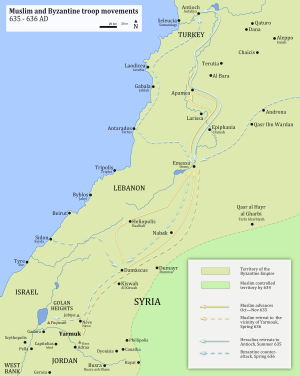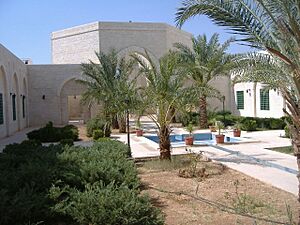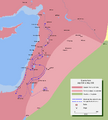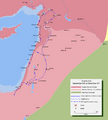Abu Ubayda ibn al-Jarrah facts for kids
Quick facts for kids
Abu Ubayda ibn al-Jarrah
أبو عبيدة بن الجراح Amin ul-Ummah
|
|
|---|---|
| Governor of the Levant | |
| In office 634–639 |
|
| Monarch | Umar Ibn al-Khattab |
| Preceded by | Office established |
| Succeeded by | Muawiyah I |
| Commander-in-chief of the Rashidun Army |
|
| In office 634–639 |
|
| Monarch | Umar Ibn al-Khattab |
| Preceded by | Khalid Ibn Walid |
| Personal details | |
| Born | c. 583 Mecca, Hejaz, Arabia |
| Died | c. 639 (aged 55–56) Jordan Valley (Middle East) |
| Burial place | Ammata, Jordan |
| Known For | Being a companion of Muhammad; one of the ten to whom Paradise was promised |
| Religion | Islam |
| Parent(s) | Abdullah ibn al-Jarrah (father) |
| Tribe | Quraysh |
| Military service | |
| Allegiance | Muhammad (624–630) Rashidun Caliphate (632–639) |
| Branch/service | Rashidun army |
| Years of service | 632–639 |
| Rank | Field Commander (632–634) Commander-in-chief (634–639) |
| Battles/wars |
|
Abu Ubayda ibn al-Jarrah (born around 583 CE, died 639 CE) was a very important Muslim leader and a close friend of the Islamic prophet Muhammad. He is famous for being one of the "ten to whom Paradise was promised." He was a top commander in the Rashidun Army during the time of Caliph Umar. Abu Ubayda was even considered to be a possible successor to Umar, but he sadly died from a plague in 639 CE.
Contents
Early Life and Family
Abu Ubayda belonged to a respected family called the Balharith, which was part of the Quraysh tribe in Mecca. His family was known for being allies with Muhammad's family before Islam. His father, Abdullah, was a leader in some battles before Islam. Abu Ubayda was known for being modest and brave even before he became a Muslim.
Becoming a Companion of Muhammad
Around 611 CE, Muhammad began teaching about one God in Mecca. Abu Ubayda became a Muslim very early on, just one day after Abu Bakr, when he was 28 years old.
Like other early Muslims, Abu Ubayda faced many challenges and difficulties in Mecca. They were often treated badly by the Quraysh tribe.
In 623 CE, when Muhammad and his followers moved from Mecca to Medina (an event called the Hijra), Abu Ubayda also made the journey. In Medina, Muhammad made each immigrant (Muhajir) a "brother in faith" with a local resident (Ansari). Abu Ubayda was paired with Muhammad ibn Maslamah.
Military Service Under Muhammad
Early Battles
In 624 CE, Abu Ubayda fought in the Battle of Badr, the first big battle between Muslims and the Quraysh. In this battle, he even fought against his own father, who was on the side of the Quraysh, and defeated him.
A year later, in 625 CE, he fought in the Battle of Uhud. During this battle, when the Muslim army was attacked from behind, many soldiers ran away. But Abu Ubayda stayed firm and protected Muhammad from attacks. He even lost two front teeth while trying to remove pieces of Muhammad's armor that had stuck in his cheek.
Later Expeditions
In 627 CE, Abu Ubayda took part in the Battle of the Trench and the Invasion of Banu Qurayza. He also led a small group of soldiers to stop tribes that were attacking nearby villages.
In 628 CE, he was a witness to the Treaty of Hudaybiyyah, an important peace agreement. Later that year, he joined the Muslim campaign to Khaybar.
When the Muslim army took over Mecca in 630 CE, Abu Ubayda led one of the four groups that entered the city. He also fought in the Battle of Hunayn and the Siege of Ta'if. He was part of the Tabuk campaign led by Muhammad. After returning from Tabuk, Muhammad sent Abu Ubayda to guide a Christian group from Najran who were interested in Islam. He also worked as a tax collector in Bahrain. He was in Mecca when Muhammad passed away in 632 CE.
In 629 CE, Abu Ubayda led an army that included Abu Bakr and Umar to defeat an enemy force. Later that year, he led another group to find the routes of Qurayshi trade caravans.
Role in Choosing the Next Leader
When Muhammad died in 632 CE, Muslims disagreed about who should lead them next. Some wanted a leader from Muhammad's family, like Ali. Others supported Abu Bakr because he was older and very close to Muhammad.
Abu Bakr, Umar, and Abu Ubayda worked together to help Abu Bakr become the first caliph (leader). Some historical accounts say that Umar even suggested Abu Ubayda as caliph first, but Abu Ubayda humbly refused and supported Abu Bakr.
Commander in Syria
Leading the Army
After some internal conflicts in Arabia ended, the new Caliph Abu Bakr sent Muslim armies to conquer Byzantine Syria. Abu Ubayda was one of the commanders. Later, Caliph Umar made Abu Ubayda the supreme commander of the Muslim armies in Syria, replacing Khalid ibn al-Walid. This change happened around 636 CE, possibly after the important Battle of the Yarmuk. Abu Ubayda was chosen because he was a skilled administrator, which was needed after the major victories.
Conquering Damascus
The Muslim armies, led by Khalid ibn al-Walid, defeated a large Byzantine army at the Battle of Ajnadayn in July 634 CE. After this victory, Abu Ubayda and Khalid moved towards Damascus. They defeated more Byzantine armies on their way.
The Muslims then besieged Damascus for 30 days. Khalid's forces broke into the city from one side. Meanwhile, Abu Ubayda, who was besieging another gate, made a peace agreement with the city's governor. This agreement allowed the Byzantine army to leave safely.
Capturing Central Syria
After Damascus, Abu Ubayda sent Khalid to attack a fair near Beirut, where he defeated a Byzantine garrison. This victory gave the Muslims a lot of valuable goods.
With central Syria now under Muslim control, communication between northern Syria and Palestine was cut off for the Byzantines. Abu Ubayda decided to march to Fahl (Pella), a crucial area. The Byzantine army there was defeated in the Battle of Fahl in January 635 CE.
Battles for Emesa and Northern Syria
After the Battle of Fahl, the Muslim armies split up. Abu Ubayda and Khalid moved north to conquer Lebanon and northern Syria.
While the Muslims were busy at Fahl, the Byzantine Emperor Heraclius sent an army to retake Damascus. Khalid's spies found out about this plan. Khalid quickly rode back to Damascus with his cavalry and defeated the Byzantine army there.
A week later, Abu Ubayda marched to Baalbek, which surrendered easily. Abu Ubayda then sent Khalid to Emesa. Emesa and Chalcis initially agreed to a peace treaty for a year. However, the Byzantines broke the treaty by sending more troops to these cities. So, Abu Ubayda and Khalid marched to Emesa and besieged it. Emesa was finally conquered in March 636 CE after six months.
The Battle of Yarmouk
After taking Emesa, the Muslims planned to conquer all of northern Syria. Emperor Heraclius, however, had a plan to gather a huge army, possibly 200,000 strong, to take back Syria.
Khalid realized Heraclius's plan and suggested that Abu Ubayda gather all Muslim armies in one place for a decisive battle. Abu Ubayda agreed and ordered all Muslim armies in Syria to leave the conquered lands and gather at Jabiya. This move ruined Heraclius's plan to fight them separately. On Khalid's suggestion, Abu Ubayda then moved the army to the plains of the Yarmouk River, a good place for cavalry.
The two massive armies met in July 636 CE. After a month of talks, the Battle of Yarmouk began on August 15th. It lasted for six days and ended in a huge defeat for the Byzantines. This battle is considered one of the most important in history, as it sealed the fate of Byzantine control over Syria.
Capturing Jerusalem and Northern Syria
With the Byzantine army defeated, the Muslims quickly took back the lands they had conquered before Yarmouk. Abu Ubayda and his commanders decided to conquer Jerusalem. The siege lasted four months. The city agreed to surrender, but only to Caliph Umar himself. Umar came, and Jerusalem surrendered in April 637 CE.
After Jerusalem, the Muslim armies split up again. Abu Ubayda and Khalid, with a strong army, moved north to conquer all of northern Syria. They captured Chalcis, a very important Byzantine fort, in June 637 CE. Then they besieged Aleppo, capturing it in October 637 CE after strong resistance. Their next target was Antioch, a major city.
Before attacking Antioch, Khalid and Abu Ubayda cut off the city from Anatolia. They captured Azaz and then attacked Antioch. A desperate battle, known as the Battle of Iron Bridge, was fought. The Byzantines were defeated and retreated into Antioch. The Muslims then besieged the city, and Antioch surrendered on October 30, 637 CE.
Abu Ubayda then captured coastal areas like Lazkia and Tartus. Khalid moved north and raided territory deep into Anatolia.
Defending Emesa and Further Campaigns
After the huge defeat at Yarmouk, the Byzantine Empire was very weak. To gain time to rebuild its defenses, Emperor Heraclius asked Christian Arab tribes from Al-Jazira to attack Emesa, where Abu Ubayda had his headquarters. Abu Ubayda pulled back all his forces to Emesa. Caliph Umar helped by sending Muslim armies from Iraq to invade the Christian Arabs' homeland, forcing them to leave the siege of Emesa and go back to defend their own lands.
After this, Umar ordered the conquest of Al-Jazira, which was completed by late summer 638 CE. Abu Ubayda then sent Khalid and another commander to invade Byzantine territory north of Al-Jazira. They captured cities like Edessa and Diyarbakır, and even parts of Armenia and Anatolia. However, Umar stopped further invasions into Anatolia for a while, telling Abu Ubayda to focus on strengthening Muslim rule in Syria.
Helping During the Famine
In 638 CE, Arabia faced a severe drought, causing a famine and diseases. Many people gathered in Medina for food. Caliph Umar asked his governors for help.
Abu Ubayda was the first to send aid. His caravans arrived in Medina with 4,000 camels loaded with food. Umar appointed Abu Ubayda to distribute this food to the thousands of people. Umar offered Abu Ubayda money as a thank you, but Abu Ubayda refused, saying he did it for God.
The Plague of Amwas
Soon after the famine, a terrible plague spread in Syria and western Iraq. It was especially bad in Syria. Caliph Umar was on his way to Syria but turned back when his companions advised him not to enter a place with an epidemic, following Muhammad's teachings.
Umar wanted Abu Ubayda to leave the plague-stricken area because he considered him a potential successor. But Abu Ubayda refused, saying he knew why Umar wanted him to leave, but that no one lives forever. He believed it was his duty to stay with his army. He also followed Muhammad's teaching that if a place is hit by a plague, people inside should not leave, and people outside should not enter.
Death
Abu Ubayda eventually caught the plague himself after moving to Jabiya, a higher area. Before he died, he appointed Muadh ibn Jabal as his successor. Abu Ubayda passed away in 639 CE. He did not have any children.
Character and Legacy
Abu Ubayda was described as tall and slim, with a bright face and a modest beard. People found him pleasant to be around. He was very polite, humble, and a bit shy, but he became very serious and alert in difficult situations.
Muhammad called Abu Ubayda the "man of trust" of the Muslim community. He was also known as "the strong and the trustworthy." He chose to live a simple life. When Caliph Umar visited Syria, he was pleased to see that Abu Ubayda, despite his success in battles, lived very simply, with only a bed, a sword, and a shield in his home.
Muslims believe he is one of the "ten to whom Paradise was promised" during their lifetime. An air base in Iraq, the Ubaydah Bin Al Jarrah Air Base, is named after him.
Tomb
Since the 13th century, Abu Ubayda's tomb has been believed to be in the village of Ammata in the Jordan Valley. This area became known as 'Ghawr Abi Ubayda'. Earlier, some thought his tomb was in Tiberias or Beisan. The family who traditionally cared for the tomb, the Jarrahs, claimed to be his descendants and were excused from paying taxes by the Ottoman rulers.
See Also
 In Spanish: Abu Ubáidah ibn al-Yarrah para niños
In Spanish: Abu Ubáidah ibn al-Yarrah para niños
- 7th century in Lebanon § Ṣaḥāba who have visited Lebanon
- List of Sahabah
- The ten to whom Paradise was promised
- Sunni view of the Sahaba
- List of expeditions of Muhammad
Images for kids






